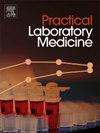Patient-based pre-classified real-time quality control with neural network (PCRTQC-NN)
IF 1.3
Q3 MEDICAL LABORATORY TECHNOLOGY
引用次数: 0
Abstract
Objectives
Patient-based real-time quality control (PBRTQC) is essential for clinical laboratory management but struggles with detecting small systematic errors. This study presents the patient-based pre-classified real-time quality control with neural network (PCRTQC-NN) model, utilizing neural networks to improve error detection by extracting analytical features from testing instruments.
Methods
Using PCRTQC's clustering analysis, we pre-classified and processed Na, CHOL, ALT, and CR data from 611,031 patients. A neural network autoencoder, trained using TensorFlow with mean squared error (MSE) as the loss function, extracted the testing instrument's analytical features under error-free conditions. Systematic errors were identified by comparing reconstruction residuals between test and reconstructed data. The average number of patient samples until error detection (ANPed) evaluated the model performance.
Results
The PCRTQC-NN's error detection surpasses traditional algorithms Compared to PCRTQC, it reduced the ANPed for ALT by 37 % (constant error, CE) and 22 % (proportional error, PE) at 1 total error allowable (TEa), with comparable results for other analytes. For 0.5 TEa errors, the ANPed for CHOL decreased by 23 % (CE) and 22 % (PE), for ALT by 14 % (CE) and 6 % (PE), and for CR by 4 % (CE) and 9 % (PE), enhancing error detection capabilities for analytes with high inter-individual variability and sensitivity to smaller errors.
Conclusions
PCRTQC-NN significantly enhances systematic error detection compared to PCRTQC, leveraging autoencoders to extract analytical features as discrete signals, thus improving SNR for high-variability analytes. It promises improved laboratory efficiency and inter-laboratory standardization via robust feature models. Future multi-center studies will validate broad applicability across diverse settings.
基于患者的神经网络预分类实时质量控制
目的基于患者的实时质量控制(PBRTQC)对临床实验室管理至关重要,但难以发现小的系统错误。本研究提出了基于患者的神经网络预分类实时质量控制(PCRTQC-NN)模型,利用神经网络通过提取检测仪器的分析特征来改进错误检测。方法采用PCRTQC聚类分析,对611031例患者的Na、CHOL、ALT和CR数据进行预分类和处理。使用TensorFlow训练神经网络自编码器,以均方误差(MSE)作为损失函数,在无误差条件下提取测试仪器的分析特征。通过对比试验数据和重建数据的残差,识别系统误差。直到错误检测(ANPed)的患者样本的平均数量评估模型的性能。结果PCRTQC- nn的误差检测优于传统的PCRTQC算法,在允许的总误差(TEa)为1时,它将ALT的ANPed降低了37%(恒定误差,CE)和22%(比例误差,PE),与其他分析物的结果相似。对于0.5 TEa误差,CHOL的ANPed降低了23% (CE)和22% (PE), ALT降低了14% (CE)和6% (PE), CR降低了4% (CE)和9% (PE),增强了对具有高个体间变异性和对较小误差敏感的分析物的错误检测能力。结论与PCRTQC相比,spcrtqc - nn显著增强了系统错误检测,利用自编码器作为离散信号提取分析特征,从而提高了高变异性分析的信噪比。它承诺通过鲁棒特征模型提高实验室效率和实验室间标准化。未来的多中心研究将验证在不同环境下的广泛适用性。
本文章由计算机程序翻译,如有差异,请以英文原文为准。
求助全文
约1分钟内获得全文
求助全文
来源期刊

Practical Laboratory Medicine
Health Professions-Radiological and Ultrasound Technology
CiteScore
3.50
自引率
0.00%
发文量
40
审稿时长
7 weeks
期刊介绍:
Practical Laboratory Medicine is a high-quality, peer-reviewed, international open-access journal publishing original research, new methods and critical evaluations, case reports and short papers in the fields of clinical chemistry and laboratory medicine. The objective of the journal is to provide practical information of immediate relevance to workers in clinical laboratories. The primary scope of the journal covers clinical chemistry, hematology, molecular biology and genetics relevant to laboratory medicine, microbiology, immunology, therapeutic drug monitoring and toxicology, laboratory management and informatics. We welcome papers which describe critical evaluations of biomarkers and their role in the diagnosis and treatment of clinically significant disease, validation of commercial and in-house IVD methods, method comparisons, interference reports, the development of new reagents and reference materials, reference range studies and regulatory compliance reports. Manuscripts describing the development of new methods applicable to laboratory medicine (including point-of-care testing) are particularly encouraged, even if preliminary or small scale.
 求助内容:
求助内容: 应助结果提醒方式:
应助结果提醒方式:


